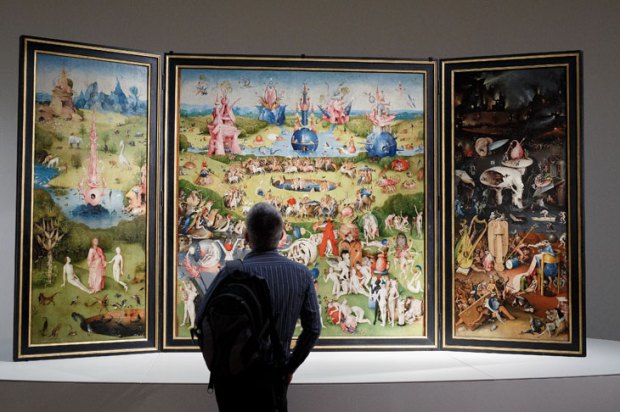After a year of living in Sydney, the smog in Hong Kong is a shock. I do not see even a glimpse of sunshine – just a wet, sickly haze. And yet Hong Kong is the most bewitching of cities. As dusk descends it transforms from a grimy, grubby, glorious mess to a fairyland of high-rises lit up like fireflies.
It is the season of Art Basel. The art fair is spread over two enormous floors in Wan Chai’s unremittingly grim Convention and Exhibition Centre. Hong Kong is a hub for finance in Asia and, I am told, culture now too. The Davidoff cocktail party at the Grand Hyatt’s roof garden on the opening night, however, is more undignified rugby scrum than get-together for the most important tastemakers of the art world. Free-flow fat brown cigars match the champagne. The hungry rabble throng tables groaning with food – paella, sashimi, roast beef, sugary cakes – leaving only dirty plastic plates. No one talks. They are all too busy eating.
Another night, another rooftop party. The Paris-based sculptor and designer Arik Levy tells me that he has started collecting art. He gives me the most sensible advice I’ve heard all week. First, don’t think money makes a collector; ten dollars is enough to get you started. Second, only ever buy from an artist of your own generation (they’re better value). Third, never listen to what anyone else has to say.
I pull up a chair next to the buoyant artist Jeffrey Gibson at Art Central, Art Basel’s younger, edgier cousin. Gibson is part Choctaw, part Cherokee and his sculptures comment on a certain brand of American nostalgia. Pieces like the eerie hollow figure Can’t Take My Eyes Off Of You, made from tipi poles and deer rawhide, merge Native American costumes with iconic song lyrics. True to great American discourse, Gibson tells me his own coming-of-age story. As a young man he spent his very first pay cheque on a Burberry duffel coat. Decades later, after years of wear and toil, the toggles finally fell off. Now one is strung on one of his sculptures alongside the beads, jingle and fringe. I try to suppress the niggling voice of my mother in my head: ‘Oh darling, you could have just sewn it back on.’
Art is now viewed, like most of modern life, through our smartphones. We do not feel like we have experienced a great painting or sculpture without snapping it first – then sharing it on social media. I’m as guilty as anyone else. Unlike literature, music, or movies it is harder to enjoy art at home. It seems unattainable, out of reach, hung as it is on the grand and intimidating walls of state galleries and museums. The indecipherable babble of ‘art speak’ – the worst kind of writing – has not helped. The smartphone, though, has de-mystified the appreciation of art. It is an equalizer on a scale never yet before seen. I am not always a fan, though. Taking pictures of art is one thing; our own faces another. At the Sydney Opera House last month a young gangly Chinese tourist – all flapping legs and arms – tried to record for posterity his trip to Faust with his selfie-stick. That’s fine. Except he was in his seat, squeezed between octogenarian opera-goers. The risk of taking out a granny or two was high.
Thankfully, no selfie-sticks were in sight at The Amahs, a new play commissioned and produced by the Hong Kong Arts Festival. Written by Roger Lee it tracks the fates of three amahs – young women from southern China who travelled to Hong Kong in the 1950s to work as servants. Most never married, sending their wages back home and pledging allegiance to each other instead of a man. Theirs was not an easy life and watching the packed-out play it was hard not to think of the Filipino and Indonesian maids in Hong Kong today who battle prejudice, poverty, and, as in the case of 23-year-old Erwiana Sulistyaningsih, horrific beatings and abuse. Lee has given the amahs a voice. Let’s hope one day other domestic workers will have one too.
It is now six months after the pro-democracy Occupy protests and little has changed. A smattering of tents still stand and some students scribble away inside, doing their homework and fighting for a better future. Not everyone wants them to succeed. I go to interview the only foreign performer of Cantonese opera in Hong Kong, New Yorker Pui Yan Li, the daughter of opera singers who immigrated to America in the 1970s. I meet Pui Yan backstage at Kowloon’s dusty Art Deco Yau Ma Tei Theatre. Nearby, in the street markets, no less than three stalls manned by elderly women sell scary-looking dildos (presumably they don’t test the products out themselves). But here at the Yau Ma Tei life follows centuries old convention. The spirited, outspoken Pui Yan went to the protests but admits most opera singers are exasperated by the kerfuffle. Media covering the Umbrella Movement has rarely focused on those who do not want to upset the status-quo, and are happy, or at least resigned, to Communist Party rule. In the traditional world of Cantonese opera – where obedience is paramount and speaking out against one’s elders is a sin – the protestors are viewed as upstarts. As Pui Yan explains: ‘You should always just follow what is set out for you and no questions asked.’
The shadow of China is never far away. I visit the Hong Kong International Film Festival but directors and curators are cagey about saying anything that might upset China – and which might leave them blacklisted from a billion-dollar film industry. It is not only film types. Everyone I talk to in the arts world passionately defends Hong Kong’s right to expression. But then quickly, sheepishly, they ask me could I possibly not put their opinions on silly things like politics down on paper? Freedom of speech, maybe – but when it comes down to it, most people are scared to say anything at all.
Got something to add? Join the discussion and comment below.
Get 10 issues for just $10
Subscribe to The Spectator Australia today for the next 10 magazine issues, plus full online access, for just $10.
You might disagree with half of it, but you’ll enjoy reading all of it. Try your first month for free, then just $2 a week for the remainder of your first year.













Comments
Don't miss out
Join the conversation with other Spectator Australia readers. Subscribe to leave a comment.
SUBSCRIBEAlready a subscriber? Log in